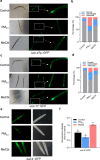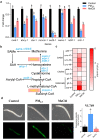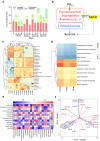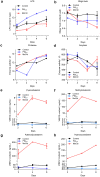PM2.5 induced neurotoxicity through unbalancing vitamin B12 metabolism by gut microbiota disturbance
- PMID: 37842922
- PMCID: PMC10580859
- DOI: 10.1080/19490976.2023.2267186
PM2.5 induced neurotoxicity through unbalancing vitamin B12 metabolism by gut microbiota disturbance
Abstract
Fine particulate matter (PM2.5) in the atmosphere is easily accompanied by toxic and harmful substances, causing serious harm to human health, including cognitive impairment. Vitamin B12 (VitB12) is an essential micronutrient that is synthesized by bacteria and contributes to neurotransmitter synthesis as a nutrition and signaling molecule. However, the relationship between VitB12 attenuation of cognitive impairment and intestinal microbiota regulation in PM2.5 exposure has not been elucidated. In this study, we demonstrated that PM2.5 caused behavioral defects and neuronal damage in Caenorhabditis elegans (C. elegans), along with significant gene expression changes in neurotransmitter receptors and a decrease in VitB12 content, causing behavioral defects and neuronal damage in C. elegans. Methylcobalamin (MeCbl), a VitB12 analog, alleviated PM2.5-induced neurotoxicity in C. elegans. Moreover, using in vivo and in vitro models, we discovered that long-term exposure to PM2.5 led to changes in the structure of the gut microbiota, resulting in an imbalance of the VitB12-associated metabolic pathway followed by cognitive impairment. MeCbl supplementation could increase the diversity of the bacteria, reduce harmful substance contents, and restore the concentration of short-chain fatty acids (SCFAs) and neurotransmitters to the level of the control group to some degree. Here, a new target to mitigate the harm caused by PM2.5 was discovered, supplying MeCbl for relieving intestinal and intracellular neurotransmitter disorders. Our results also provide a reference for the use of VitB12 to target the adjustment of the human intestinal microbiota to improve metabolic disorders in people exposed to PM2.5.
Keywords: Vitamin B12; atmospheric particulate matter; gut microbiome; in vitro colonic simulation system; methylcobalamin; neurotransmitters.
Conflict of interest statement
No potential conflict of interest was reported by the author(s).
Figures







Similar articles
-
Methylcobalamin Alleviates Neuronal Apoptosis and Cognitive Decline Induced by PM2.5 Exposure in Mice.J Alzheimers Dis. 2022;86(4):1783-1796. doi: 10.3233/JAD-215384. J Alzheimers Dis. 2022. PMID: 35253753
-
Effects of inhaled fine particulate matter on the lung injury as well as gut microbiota in broilers.Poult Sci. 2024 Apr;103(4):103426. doi: 10.1016/j.psj.2024.103426. Epub 2024 Jan 6. Poult Sci. 2024. PMID: 38335666 Free PMC article.
-
Effects of PM2.5 exposure during gestation on maternal gut microbiota and pregnancy outcomes.Chemosphere. 2020 May;247:125879. doi: 10.1016/j.chemosphere.2020.125879. Epub 2020 Jan 9. Chemosphere. 2020. PMID: 31935575
-
Vitamin B12 Deficiency and the Nervous System: Beyond Metabolic Decompensation-Comparing Biological Models and Gaining New Insights into Molecular and Cellular Mechanisms.Int J Mol Sci. 2024 Jan 2;25(1):590. doi: 10.3390/ijms25010590. Int J Mol Sci. 2024. PMID: 38203763 Free PMC article. Review.
-
Current Nanocarrier Strategies Improve Vitamin B12 Pharmacokinetics, Ameliorate Patients' Lives, and Reduce Costs.Nanomaterials (Basel). 2021 Mar 16;11(3):743. doi: 10.3390/nano11030743. Nanomaterials (Basel). 2021. PMID: 33809596 Free PMC article. Review.
Cited by
-
Unraveling the mechanisms underlying air pollution-induced dysfunction of the oral-gut-brain axis: implications for human health and well-being.Asian Biomed (Res Rev News). 2025 Feb 28;19(1):21-35. doi: 10.2478/abm-2025-0002. eCollection 2025 Feb. Asian Biomed (Res Rev News). 2025. PMID: 40231163 Free PMC article. Review.
-
A Multi-Omics Study of Neurodamage Induced by Growth-Stage Real-Time Air Pollution Exposure in Mice via the Microbiome-Gut-Brain Axis.Toxics. 2025 Mar 29;13(4):260. doi: 10.3390/toxics13040260. Toxics. 2025. PMID: 40278577 Free PMC article.
-
Simultaneous Determination of Three Active Forms of Vitamin B12 In Situ Produced During Fermentation by LC-MS/MS.Foods. 2025 Jan 17;14(2):309. doi: 10.3390/foods14020309. Foods. 2025. PMID: 39856975 Free PMC article.
References
-
- Eze IC, Hemkens LG, Bucher HC, Hoffmann B, Schindler C, Künzli N, Schikowski T, Probst-Hensch NM. Association between ambient air pollution and diabetes mellitus in Europe and North America: systematic review and meta-analysis. Environ Health Perspect. 2015;123(5):381–389. doi: 10.1289/ehp.1307823. - DOI - PMC - PubMed
-
- Hamra GB, Guha N, Cohen A, Laden F, Raaschou-Nielsen O, Samet JM, Vineis P, Forastiere F, Saldiva P, Yorifuji T, et al. Outdoor particulate matter exposure and lung cancer: a systematic review and meta-analysis. Environ Health Perspect. 2014;122(9):906–911. doi: 10.1289/ehp/1408092. - DOI - PMC - PubMed
Publication types
MeSH terms
Substances
LinkOut - more resources
Full Text Sources
